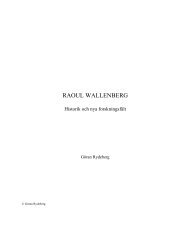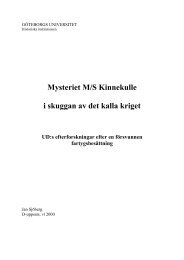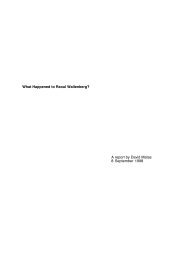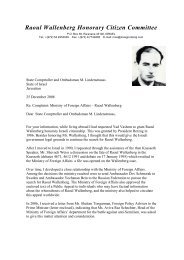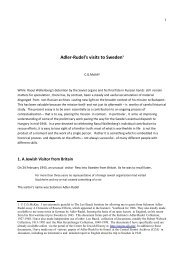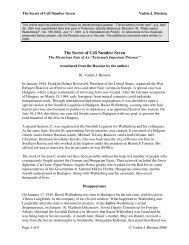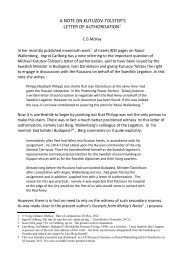raoul wallenberg swedish humint actions during ww2 - Searching for ...
raoul wallenberg swedish humint actions during ww2 - Searching for ...
raoul wallenberg swedish humint actions during ww2 - Searching for ...
Create successful ePaper yourself
Turn your PDF publications into a flip-book with our unique Google optimized e-Paper software.
In order to support contacts with useful international actors, Ternberg travelled to Germany<br />
and Austria several times <strong>during</strong> the years of WW2. There are some indications, though not<br />
fully confirmed, that Ternberg also visited Hungary at least in 1943 and 1944. We do not<br />
know whether the legation was in<strong>for</strong>med of these visits, but there is reason to believe that it<br />
was not.<br />
In order to secure the transfer of in<strong>for</strong>mation from abroad, Sweden and other countries mostly<br />
used their embassies/legations to send encrypted messages to the home capital. The facilities<br />
<strong>for</strong> doing this at the Swedish legation in Budapest had been supervised and ameliorated in<br />
1943 by the head of the TKA (the Swedish organisation <strong>for</strong> control of cables), Mr C. A. Elghammar.<br />
/See the files of the organisation at KrA./ The members at the legation at that time were<br />
instructed and trained in the use of encryption utilities.<br />
The cables sent from Budapest can now be found in the files of the Swedish Foreign Ministry<br />
and to some extent in the records of the Defence Ministry. In the extant documents there are<br />
no traces of any intelligence references in the messages sent from the legation. Having said<br />
that, we would certainly imagine that the most secret in<strong>for</strong>mation was passed to the Swedish<br />
authorities either by “independent” transmissions or by special couriers.<br />
According to an anonymous source who was interviewed by the author of this paper a few<br />
years ago, at the end of the war there were at least a few “independent” Swedish technicians<br />
working with radio transmissions from Hungary to Sweden. /According to Berger 2004 members of the<br />
Military Headquarters in Stockholm had in October 1944 smuggled a radio receiver to Hungary as well as instructions and other facilities to<br />
the Hungarian resistance movements. The receiver is claimed to had come into the hands of members of the MFM resistance movement./<br />
These people were not employed by the legation, but they were said at any rate to have kept in<br />
close touch with it. Their task was also to support the activities carried out by C-byrån. The<br />
source was also asked if he could remember having had any contacts with specific members<br />
of the Swedish legation and especially with Raoul Wallenberg. The answer was a definitive<br />
no.<br />
By now we know that there were at least a few Swedish covert radio stations and as will be<br />
shown, members of the Hungarian resistance movement were aware of the Swedish activities.<br />
We have no indications of whether the legation had any knowledge of this either.<br />
US/Swedish and British/Swedish connections<br />
When, in July 1944, Raoul Wallenberg was appointed First Secretary at the Swedish legation<br />
in Budapest and became head of the office <strong>for</strong> humanitarian affairs, this was a development<br />
that was both quite normal and truly extraordinary. What was normal about it was that<br />
Switzerland and other neutral countries had started similar missions quite a while be<strong>for</strong>e the<br />
Swedish initiative came into action and mostly even operated theirs on a larger scale than<br />
Wallenberg and his organisation were ever able to do. It was also normal <strong>for</strong> Sweden, like<br />
other countries, to receive money and aid from e.g. the US as well as from Jewish<br />
organisations. The extraordinary thing about Wallenberg’s mission – by comparison with, <strong>for</strong><br />
example, the Swiss <strong>actions</strong> – was that both the initiative and the financing came almost<br />
wholly from the US.<br />
To the actors on the international scene who cared about what he was doing, the purpose and<br />
conditions of Wallenberg’s mission were probably pretty vague. Even his Swedish colleagues<br />
sometimes wondered whether he was acting on behalf of Sweden or the US. During his stay<br />
he was successful and many people in Budapest – Swedes, Hungarians and ultimately the<br />
Soviet authorities – noted that Wallenberg obviously was in control of a lot of money and<br />
property. From where did he get it? How was it possible <strong>for</strong> him to carry out his mission,<br />
since it was well known that the Germans and the Hungarian authorities had threatened to<br />
stop his <strong>actions</strong>? If they did not, could he have been suspected of negotiating with – or even<br />
actively helping – the Nazis? Many questions – which in combination could easily lead us to<br />
4




